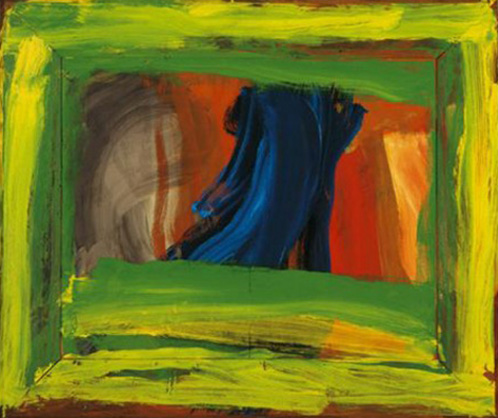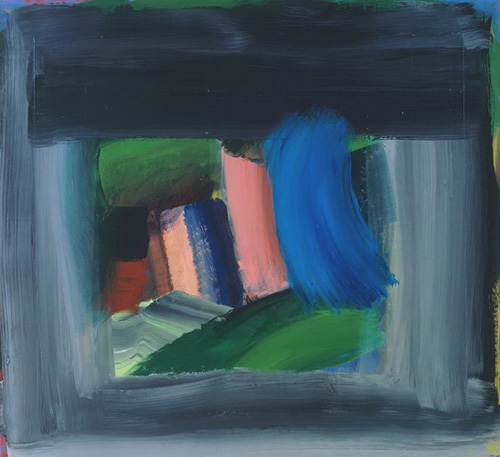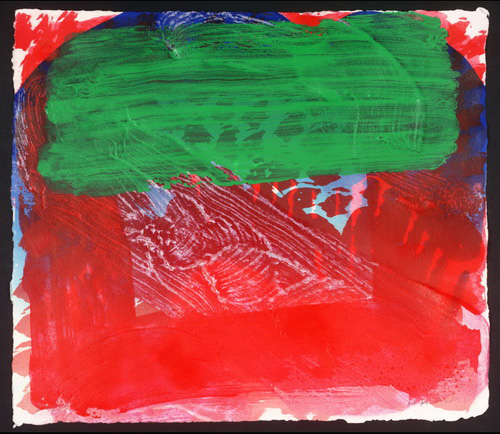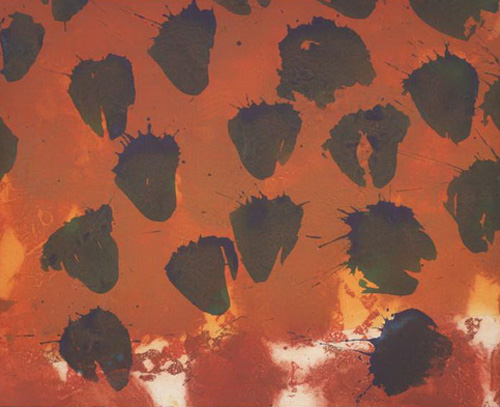Perpetual Ripplets: On Howard Hodgkin
Yuko Otomo
April 2017
 Night and Day, 1999, image courtesy of Wikiart
Night and Day, 1999, image courtesy of Wikiart
Memories of Sensations: On Howard Hodgkin
I’d like to dedicate this writing to Howard Hodgkin who passed away on March 9, 2017. He departed peacefully in a hospital in London only few weeks after returning to UK from India according to a description of one obituary. As a major figure in the modern British art (especially in the art of painting) along with Francis Bacon, Lucian Freud & David Hockney, he was a national hero of sorts & there are plenty of writings on him pouring out at the moment of his passing.
He was in the midst of preparing 2 major exhibitions that meant a lot to him personally. One is his portrait painting show: Howard Hodgkin: Absent Friends at National Portrait Gallery, March 23 – June 18, 2017, in London & another is the show of his paintings done in India: Howard Hodgkin: Painting India at The Hepworth Wakefield, July 1 – Oct. 8, 2017, in Yorkshire. His portrait works are seldom shown anywhere, which have deprived both artist & the viewers. The exhibition showing 35 of his works done in India, including the last 6 paintings he did there, is to examine his creative relationship with that country. In a 2014 interview, he claimed, “India…I couldn’t work without it…” Unfortunately, the artist will not be able to enjoy either of the exhibitions because of his untimely passing.
How fascinating it is that two contradictory statements: one that says “his art looks easy but at the same time is difficult to understand” & the other that says “his art looks difficult but at the same time is easy to understand” are both accurate because of the intensity of the “personal=universal” power of emotions that the work emanates! I got to know him & his art quite late in my life when his art was first introduced in NYC in 1990. Since my first exposure, his art has occupied a very special place in my world. His creative linage goes back to Bonnard, Vuillard & Matisse as well as to traditional Indian miniature paintings, such as the Mughal-derived Pahari paintings, which he avidly collected. As a matter of fact, his collection of Indian art was shown as Vision of Mughal India: The collection of Howard Hodgkin at Aga Khan Museum, Toronto, Canada in 2015. I never stop regretting that I missed his talk with Susan Sontag at the MET in 1995, with whom he did a collaboration project: The Way We Live Now (1991).
He was an artist who was clearly aware of a “moral calling” to be an artist. Seeing Piano Lesson by Matisse at the age 5, he became determined to be an artist. Starting with the first painting Memories, done at 16, his life was totally dedicated to the art of painting all through his life till the very end. Unlike myself, who loves to listen to music while working, he worked in silence without music or the radio on. He focused on one painting alone, covering the other works with a cloth as he worked on multiple works. He was one of the living artists of our time I’d longed to meet in person, not to discuss art, but to spend some time with him, enjoying ordinary things such as taking a walk or looking at flowers together. As a tribute to him, I decided to translate 3 of my writings on him, 2 small, & one substantial, all written originally in Japanese quite a while ago in the 90s, into English to share them with anyone who is curious of his “delightfully deep & eloquently emotional” world. I’m opening this tribute with the poem titled Afternoon Flowers, which I wrote for him after seeing the MET exhibition in 1995.
 Rain, 1989, image courtesy of Wikiart
Rain, 1989, image courtesy of Wikiart
Afternoon Flowers: A Song (for Howard Hodgkin)
I have no name.
The name they gave me
is not
mine.
I do not move,
nor talk,
although I have so many lovely things
I’d love to share with others.
I grow to stand
& will die in seeds
to grow
again.
He is looking at me
& I know that
he knows that
I am looking at him, too!
Oh, what a day!
It is afternoon!
We are both bleeding
out of joy!
Will I miss him
when he passes through me?
Sure! I will!
I will cry definitely, clearly & brightly, then.
1. in his own words
I hate painting.
I am a representational painter but not a painter of appearances.
I don’t care a damn about what happens when I’m dead, but I do have a sense of increased urgency. And I think it’s made me more courageous.
Mostly painting is like putting a message in a bottle & flinging it into the sea.
I believe very strongly in the autonomy of the picture.
A painting is finished when the subject comes back, when what has caused the painting to
be made comes back as an object.
I am isolated as an artist, not as a person.
Matisse was very clear about saying that you have to blow your own trumpet &
explaining yourself, which I think has been slightly forgotten.
I fell in love with Indian Art when I was at school… I longed to visit India, but only
managed to do so in my early twenties. It proved a revelation. It changed my way of
thinking and, probably, the way I paint…
 Strictly Personal, 2001, image courtesy of Wikiart
Strictly Personal, 2001, image courtesy of Wikiart
2. Howard Hodgkin @ Knoedler & Co. Gallery, NYC 1990
My curiosity about this British artist got heightened after reading the article on him & seeing the image of his work in the recent NYTimes No Need to Hurry. Instead of banging passion onto his materials, he waits for something to swell naturally out of his existence to fall onto them. Today is the last day of this gallery show, so I took a subway uptown in the afternoon. Because of the high profile article in the paper, there were many viewers, like myself, eager to take a glimpse at his world, who busily occupied the gallery space.
First, I tried to walk around to see the show without having any reference points so as to be pulled by the art itself. Clarity of colors, brush strokes & their sense of speed looked freed from the sense of being heavy or light, fast or slow, successfully merging their elements with the cosmic pace of time passing. I walked around again, this time to see the whole thing with a prepared list of titles. Discarded Clothes; Indian Sky; Fire In Venice; On the Edge of the Ocean; Rain; It Can’t be True; In Tangier; In the Black Kitchen… Big strokes move on hard wood, the material different from the usual canvas, as if to purge out various realities that had once entered inside the artist’s being. The most remarkable thing about Hodgkin is that he never cheats on the process of creation. In other words, all the various aspects of reality (sensed by the 5 senses of sight, sound, smell, touch, taste, plus consciousness & intuition) all go inside him as a natural phenomenon, reaching thoroughly to the very end-limit of his being. After settling themselves down inside his existence, they seek for an exit to free themselves again into the outer reality. Hodgkin never rushes through this process. It’s almost as if he is giving up his human will to force anything. The significant meaning of his art resides on this point of accuracy & an existential sincerity in dealing with the phenomenon.
The “joyfulness” of the clarity of his colors comes from his inherited personality, & it does not have too much to do with the philosophical aspects of his art, I assume. The same can be said about his motifs. Black Kitchen can be Red Kitchen & On the Edge of the Ocean can be On the Edge of the Mountain. The point is the fact that Hodgkin allows himself to experience the process itself with such an attitude of genuineness & truthfulness. Everything our senses react to goes inside us whether we are conscious of it or not. He is brilliantly open to the process, delightfully giving himself up to it. He lets this reality enjoy its own freedom to reach its maximum threshold of fullness & limitlessness within his existence. Unlike most humans who never let their reactions go below the neck in order to stay in the cerebral sphere alone inside them, he generously enjoys letting a reaction take over his whole existence. He open-heartedly assists that reaction’s taking its own course of processing his existence internally as if it were a natural act. By doing so, he recreates “subjects” that his extremely delicate personal sensitivity has perceived & reacted back onto materials as “art.”
The color “red” in Fire in Venice speaks of various uncountable fires there. It expresses the endless dimensional layers of fires in a literal, philosophical, historical, poetic, political, geographical & musical sense. As a result, it manages to show all fires in Venice in one color, “red.” The same thing can be said about Small Rain. This “blue/green” presents us all of the literal, philosophical, historical and poetic aspects of the rain that Hodgkin’s personal “skin” sensitivity has reacted to. The overall sensitivity centers on lyricism due to his personal tendency. Yet, his lyricism is filled with universal dynamism. When I think of the reality of humanity’s having fallen into a muddling confusion because we put too much emphasis on the cerebral aspects of our being, I cannot state strongly enough the importance of Hodgkin’s art & his attempts. Nothing to Hurry. No Need to Hurry. His “pace” of processing his art is somewhat Duchampian in a very special way, or even more so.
(written 12/1/1990)
3. Howard Hodgkin: Paintings 1975 – 1995 @ The Metropolitan Museum, NYC 1995
When we got to the exhibition space, the museum was almost closing & we did not have enough time. We only had 10 minutes. So, we just walked around to feel breaths & the strange “luminosity” of his art. Interestingly, I did not get any of the odd & non-agreeable feelings I’d gotten when I’d seen his large scale works in the confined space of Knoedler & Co. a few years back. In the MET exhibition space, big enough for large scale works as well as modest scale works, his art emanated power & life equally well. A question of “density” came to my mind. As seemingly scattered brush strokes & his method of building up make an apparent sense of yin/yang, I became aware of the density of his spiritual elements & their tremendous intensity that seems to come from the compressed brilliance of colors. It is truly fascinating to witness the mixture of some colors that would usually end up being muddy deepening purity in his work as if it were a miracle.
(written 12/19/1995)
4. on Howard Hodgkin
When we went to the Hodgkin exhibition at the MET in mid December, we couldn’t really observe it because of the lack of time. In order to see the film on him & to see the exhibition under the right conditions, we brought ourselves back to the museum again. Although we wished to see the show itself before seeing the 2 short TV interview films, the idea had to be given up because of the time scheduled set for them. So, we ended up seeing 2 TV interviews, one from 1981 & another from 1993, before seeing the show.
The first time I encountered Hodgkin’s art was at Knoedler & Co. gallery. I do not recall too well the overall impressions I got then, but I remember that I had a strong sense of conviction that the artist deserves very special attention. I was shaken by the unusually intense impact Indian Sky & Venice Sunset gave me. The dimensional uniqueness of the impact I got on seeing his art, without having had any prescribed knowledge neither on him nor on his art, was something totally unprecedented. Then, I had a 2nd opportunity to see the large sized work by him again in the same gallery one or two years later. Then, another brief encounter took place in a rush during mid December last year. So, this is my 4th exposure to his art.
Strangely, I did not feel bothered by seeing the TV interviews before seeing the actual show for some reason. Usually, I avoid others’ interpretations of art & artists as much as possible before I see actual works in order to avoid others’ ideas that could interfere with my own personal reaction to what I see. The reason is simply to maintain the purity of my own reaction as much as possible. Yet, today, I did not get irritated by seeing the TV shows first. It must be because I already had my own, still somewhat vague, but deeply solid, idea of what he & his art were, although I had never had analyzed it in words.
Both the 1981 & the 1993 English TV programs basically took the form of an interview in order to get close to the mystery of Hodgkin’s art. The interviewers asked him questions from the laymen’s point of view. Hodgkin, as if the term “non-verbal” got personified, spoke of himself & his art with sparse words, but accurately. What I learned from these 2 interview films were the basics of his method of creative process. In his words: “I’m interested in human experiences, but not in human appearances.” That summarized the scope of his art. In the 1993 show, he said, as if he were spitting words, how hellish it was to lead the creative life. “I hate it!” he said. I understood the painful reality of what his words meant, since he dealt with “Time” & “a thought process” that belongs outside the territory of logic based on linguistics.
As for discussion of whether Hodgkin’s art is abstract or representational, the purpose of having such an argument, & the desire for a resulting conclusion to the argument, have to be discarded from the beginning. The world of Hodgkin cannot be discussed by so-called logical principles or categorizations. His is an extremely private & personal world. He sees, hear/listens, eats, feels…etc & encounters various things through living his life. It is as if he swallows his reactions inside him & ruminates over what’s going on inside him in his subconscious world. He sees things in the world with the deep glances of a child. He goes somewhere. He sits on a chair. He looks at someone. He listens to a conversation. He thinks of “something.” He becomes aware of himself thinking of “something.” Its repetitions & accumulations & the resulting purifications become the foundation of his art. Hodgkin speaks of how he starts with a rather clear narrative impression & how he sublimates the private elements, trying to reach the level of a generalized universal point in the process. His aim is to express human experiences, such as feeling a person, feeling a place, feeling the time, etc. as a pure “essence” of existence.
It was very interesting to be able to see the creative process of his work in the South Bank show. It was about how to deal with the autonomy of the process. Within its self-less condition, he gives the self up in the logic of a non-lingual thought process that reflects the basic methodology of abstraction. What fascinates me the most when I think of his relationship with “Time” is the fact that he makes it a “moral” principle of his to keep the accuracy of the genesis of the memory of an experience as much as possible throughout the process to the end. When he visualizes “something” he has experienced via ‘living life,” he makes sure to start with an accurate memory of an impact as the genesis of the creative process. Trying to maintain this accuracy throughout, he reaches the purified & crystallized essence of the experience itself. The seemingly irrational fact of his starting & concluding point being the same is one of the mysteries that solidify Hodgkin’s art.
There are no principles or logic that the rationality of language can explain about the “what & how” of his world. Most art exists on logic, philosophical creative principles or the concretized proof of those ideas, whether abstract or narrative. What makes his art special is that he does not practice his art: the art of painting, in order to prove “anything.” If there is some kind of purpose or aim, it is accuracy in visualizing memories of experience at the purest level & form possible & to reach the completed end result as the essence of the memory itself. He starts with private/personal narratives & sublimates them to the level of general/universal. In doing so, he deepens the sense of accuracy further. He reaches its natural completion, giving himself to the autonomous organic creative process of the work itself that resides outside of the territory of lingual logic. The non-lingual thought process develops itself, following its own logic, one similar to the law of nature. The process moves on a time & space of its own, surpassing the confined human sense of time & space. He thinks without words. It is evident that his art takes an immeasurable amount of time, mostly a few years, to complete one piece because of this.
Clearly, his art differs from ordinary representative art in one very particular way. He is not interested in describing the appearances of existence, but he strives to visualize its essence. He does not pay attention to appearances, the most superficial reality of existence, but tries to get closer to existence itself by visualizing its essence. No matter how hard you try to categorize his art from the angle & notion of being either abstract or representational, his art never can be framed into such categorizations. We will never know what inspires or drives him to be involved in a certain theme & material aspects of his work, since it lies in the inspiration that takes place in his private world in the most private manner. With an extremely delicate sensitivity to weather & climate, light & shadow, the vast expansiveness or closeness of space, moisture and time, he concretizes & materializes the memories of sensations of his personal fleeting reaction/reflections to these elements, transforming them into an eternal life as art.
He explains why the method of banging brushstrokes on the picture plane requires a hard wooden surface rather than the usual soft surface of canvas. A hard surface can endure the long duration of time passing in the creative process much better, he says. Interestingly, what we witness as the end result of the long, time-endured process of his unique brushstrokes is the ethereal quality of lightness. It is curious to see the hardness of the wooden surface & the intense but light brushstrokes neutralize each other, pulling both ends into a different dimension. His choice of materials, a hard wooden surface, is like a musician’s choice of an instrument that makes him feel most at home & together with himself. When I learned of his deep love & involvement with India, his collecting of Indian Miniature Paintings & his frequent visits, I understood why I saw the similar sense of luminosity, violently intense, dramatically serene & passionate, that’s shared by both Indian paintings & his own work.
It is a strange experience to witness the flow of immense time passing being condensed into such seemingly “casual” thin brushstrokes. It is also strange to see the acute sensation & consciousness of the physical/metaphysical aspects of living life being condensed into thin brushstrokes merging with each other to become “an object” on a wooden piece of material. A catalogue prepared in the exhibition space caught my eyes. In it, Susan Sontag wrote of the “muteness” of Hodgkin’s art. Yet, my mental condition, not suitable for paying attention to “words,” did not allow me to go inside of her writing, although I was extremely curious about her thoughts. Instead of delving into it, I moved on to the next room to see his recent work. Suddenly, I realized that I too wrote the word “mute’ down in my notebook in the sentence that went “it is mute only because of the lack of words.” Then soon again, I re-realized that rather than being mute, his art does not talk, but speaks passionately. I also shifted my analytical idea of his art being “poetic” to being “short story-like”.
The Hopes At Home (1973-77); Jealousy (1977); After Corot (1979-82); Clean Sheet (1982-84); In A French Restaurant (1977-79); After Dinner (1976-77); A Small Thing But My Own (1983-85); Sad Flower (1979-85); Love Letter (1984-89); Indian Sky (1988-89); The Moon (1978-80); Venice Sunset (1989); Venice Lagoon (1984-87); House Near Venice (1984-88); In Ben In Venice (1984-86); In A Crowded Room (1981-86); Snapshot (1984-93); Lovers (1984-92); Writing (1991-95); Gossip (1994-95); Bedroom Window (1992-94); Afternoon Flower (1995); When Did We Go To Morocco? (1988-93); Artificial Light (1993-95); After Morandi (1989-94)… all oil on wood… all of these works secretly embrace the world of some sort of well written complete short story. Then, I said to myself “it’s totally natural for the process to take this long duration of time!” affirming his creative process again. Witnessing “the secrets” of memories that cannot be expressed in words breathe vividly in his works, I got further captivated by his art. Then, suddenly, the word “danger” flashed in my consciousness, & I reacted sensually to the emergence of this particular word.
Post script:
“Chi” of the feeling, brightening, darkening, expanding, shrinking, rising & falling… Taste of “Chi”… atmospheres…

 Venice Afternoon, 1995, image courtesy of Wikiart
Venice Afternoon, 1995, image courtesy of Wikiart